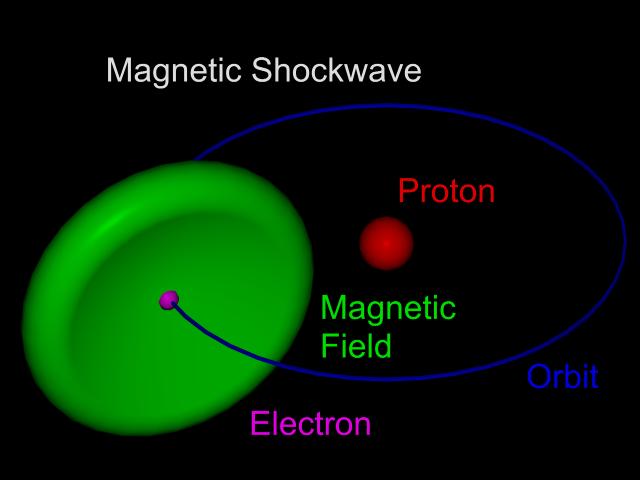1.2
Primary cause and effect:
The fundamental questions we must answer are…
1. What is the nature and source of the field that matter generates we commonly call gravity?
2. What is the nature and seat of interaction between this field and matter
that causes an attractive force to arise?
1.2.3
Second approximations:
The current loop model has an obvious flaw.
The electron is a particle and therefore discontinuous in nature.
The electron exists at one point in it's orbit at any given instant.
This means the electron's magnetic field must also be discontinuous in nature.
In other words there is a magnetic impulse or shock wave connected to, and traveling coincident with the electron as it circulates around it's orbit (figure 2).
A thought experiment is helpful at this point.
What would this magnetic field look like to an observer located in the orbital plane and an arbitrary distance (say 100,000 orbital diameters) away from the atom?
Assuming the observer is oriented so the orbital plane is horizontal, he/she would "see" a magnetic shock wave with a velocity vector in the horizontal plane and the magnetic field vector in the vertical plane.
In other words the two vectors (velocity & magnetic) would be at right angles to each other.
This is VERY important and needs generalizing.
No mater how we orient the observer with respect to the atom, the velocity vector and magnetic field vector will remain at right angles to each other.
Study the geometry until you have satisfied your self the above statement is true in all cases.
A second and more subtle observation also comes to light from this thought experiment.
In any orientation where the velocity vector is reversed so is the magnetic vector.
At first glance this may seem trivial but as we shall see, it has profound consequences...

Figure 2
1.3.3
The electrogravitic field sign:
As we noted in 1.2.3 any orientation that reversed the velocity vector, also reversed the magnetic field vector as well.
We then found in 1.3.2 the magnitude and sign of the electric field vector was equal the a cross product "X" term (B X V).
These last two statements when coupled together, produce an electric vector that is unidirectional regardless of the spin direction or orientation of the generating atom with respect to the observer.
In summary, even though the magnetic fields of any large collection of atoms cancel (except when spin aligned), their B X V components will constructively sum because two negative values, when multiplied (product term), always yield a positive result.
This asymmetry is the underlying reason we do not observe gravitational repulsion in nature.
Profound indeed!
1.3.4
The electrogravitic field magnitude:
As we travel away from the generating atom (in the orbital plane), the magnetic field magnitude attenuates as the inverse square of distance.
However the velocity magnitude rises proportionally with distance.
In other words as we double the distance the magnetic field magnitude drops to 1/4 of it's original value while the velocity magnitude doubles.
Therefore the B X V product magnitude falls at a rate proportional to the distance from the generating atom (1/r).
At first glance this may seem paradoxical.
Isn't the gravitational force inverse square?
As we shall see in part 2, a 1/r magnitude is exactly what is required to generate an inverse square force as the overall gravitational interaction...
End
Electrogravitics - A Crash Course Part 1